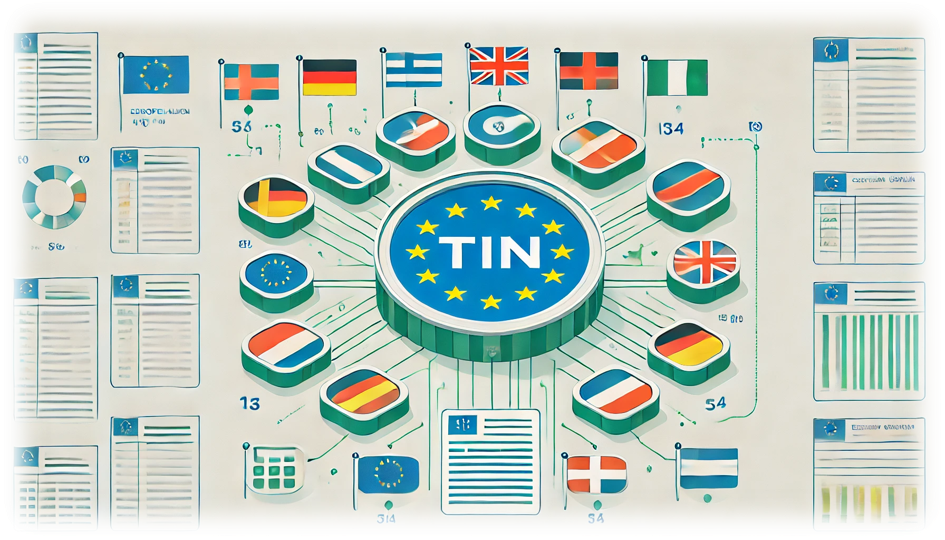In today’s global economy 🌍 accurate taxpayer identification is key to tax administration and international cooperation. In the tax systems of the European Union and many other countries special personal and company codes are used to identify taxpayers. Eesti Firma, 📊 an accounting and ⚖️ legal services provider, explains the importance of these codes for tax compliance and business and the functionality of the TIN.
What is a TIN?
A Tax Identification Number (TIN) is a number given by the tax authorities 🏛️ to identify taxpayers for tax reporting purposes. It is part of the tax system and helps the government to distinguish between individuals, companies and foreign persons, to manage their tax obligations and to process tax returns. Depending on the jurisdiction TINs can be the same as a social security number, an individual’s personal identification number or a company registration number. ✅
Where to Find your Tax ID?
You can 🔍 find examples of TINs used in EU member states and some other countries on the website of the European Commission or the Organization for Economic Cooperation and Development (OECD). 📚 These sources provide detailed information on the format, structure, and issuing authorities of TINs, helping individuals and companies correctly identify and use their tax numbers.
You can read about the use of TIN in Estonia in this article.
Taxpayer Identification Number is a unique number given by the national tax authorities 🌐 to the persons who have to pay taxes. TIN ensures accurate and unambiguous identification of both individuals and companies mainly for tax purposes like filing tax returns, making tax payments and fulfilling tax reporting obligations. TIN is used in various fields including cross-border economic activities, automatic exchange of tax information between countries and prevention of tax fraud and tax evasion. ⚠️
Types of Tax Identification Numbers
Tax identification numbers (TINs) are key to taxation and compliance for individuals and businesses. They are tools for governments to track and administer tax activities.
- Personal ID Code: Issued to individuals for identification and tax purposes. A unique numerical code that is the primary identifier for individuals, for tax reporting, government services and legal identification.
- Registration Code for Legal Entities: Issued to companies, non-profits and other legal entities to uniquely identify them for tax reporting, regulatory compliance and government institutions.
- Individual Taxpayer Identification Number (ITIN): Issued to foreign individuals and residents without local personal ID codes. For tax reporting and compliance. Typically a numeric code and required for tax filings.
- Employer Identification Number (EIN): Issued to entities that employ individuals. Used for payroll tax reporting and other employer specific tax obligations. EINs for business tax management and compliance.
- Preparer Tax Identification Number (PTIN): Mandatory identifier for tax preparers who prepare tax returns for pay. For accountability, compliance and traceability of tax preparation activities.
Knowing and using these different TINs is key to stay compliant, accurate tax reporting and smooth interaction with government authorities.
The Main Purposes and Applications of TIN
The Tax Identification Number (TIN) which is used to identify taxpayers and facilitate communication with financial institutions and government authorities is the backbone of modern tax systems around the world.
TINs provide worldwide financial transparency, compliance enforcement and administration by providing a standardised way of identification. TINs have different forms in different jurisdictions but they all serve the same purpose.
Tax Administration
TIN allows tax authorities to track and process tax returns, reconcile payment data and keep detailed records of all taxpayer activity. This helps compliance monitoring, identifies any discrepancies and manage taxpayer data, reduces administrative burden.
Financial Services
Before opening bank accounts, making loans or engaging in any financial transactions, banks and other financial institutions (insurance companies, investment firms and credit companies) often require TIN. Know Your client (KYC) identification standards and anti-money laundering (AML) regulations both rely on having a TIN to verify client identities and monitor financial activity.
International Tax Reporting
TIN is required for the exchange of financial and tax information among the European Union member states. Many administrative cooperation directives from the EU specify this. EU’s financial transparency, tax evasion prevention and information exchange is made easier with a common ID. Global programs like FATCA and CRS also rely on TIN.
Employment and Payroll
Employers record employee income, handle social contributions and fulfill payroll related tax obligations using TIN. Precise taxpayer identification numbers facilitates processing of salaries, tax withholding and submission of documents to tax authorities, ensures prompt and exact compliance with employment tax laws.
In summary, the Tax Identification Number is a key instrument for integrity and compliance in all legal systems and financial sectors and for domestic fiscal management. The key to effective and transparent tax and financial systems is its widespread adoption.
Who Uses TIN and where?
Firstly, TIN is required by national tax authorities. Each EU member state has its own version of TIN (or equivalent) for resident individuals, registered businesses, entrepreneurs and even foreigners operating in their jurisdiction. While TIN is the most common identifier, in some jurisdictions it overlaps with other identifiers, such as a social security number, employer identification number or individual taxpayer identification number.
Secondly, financial institutions use TIN. Banks, insurance companies, investment firms and other financial market participants ask their customers for their TIN. This is to comply with regulatory requirements, anti-money laundering regulations and to file correct and on time taxes to government. Moreover, TIN is required when preparing official documents related to financial transactions.
Thirdly, employers use TIN. Many employers across different countries are required to collect and store their employees’ taxpayer identification numbers. This is to accurately withhold payroll related taxes, manage employment related taxes, and file relevant tax returns and reports to tax authorities. In many countries TIN has become an integral part of payroll management and employee identification.
And TIN is used more and more in international cooperation frameworks. Global initiatives like Common Reporting Standard (CRS) use TIN as numbers to identify taxpayers and facilitate cross border data exchange between tax authorities to promote financial transparency worldwide.
EU Regulations Governing the Use of TIN
Each EU member state has its own national legislation and TIN format, but several key EU legislative instruments regulate and harmonize TIN usage in the EU:
Council Directive 2011/16/EU on Administrative Cooperation
Often referred to as the Directive on Administrative Cooperation (DAC) this act sets a legal framework for mutual assistance and information exchange between tax authorities. The aim is to combat tax fraud and evasion by exchanging the information necessary for the correct application of national tax laws. It promotes transparency and reduces opportunities for tax evasion and unfair competition between states, improves compliance and consistency.
The directive covers various forms of tax information exchange between member states, including automatic exchange (regular transfer of information such as income, financial assets and taxpayer accounts), spontaneous information exchange and exchange upon formal request.
The directive sets deadlines for responding to requests to ensure timely interaction between tax authorities. Special attention is given to data confidentiality. Transferred data can only be used for tax purposes and must comply with EU-wide personal data protection standards (GDPR).
Subsequent amendments and expansions of the directive, DAC2, DAC3, DAC4, DAC6, DAC7 include information exchange on financial accounts (DAC2), cross-border tax arrangements (DAC6), country-by-country reporting and other measures to increase tax transparency and TIN in international cooperation.
Regulation (EU) No 904/2010 on combating fraud in the field of value added tax
Another key instrument regulating TIN in the EU is Regulation (EU) No 904/2010. This regulation deals with administrative cooperation and anti-fraud measures in value added tax (VAT) in the EU.
Regulation 904/2010 creates a transparent, efficient and consistent VAT system in the EU. It promotes collaboration between member states, minimizes tax abuses and supports fair competition:
- VAT Information Exchange: Procedures for information exchange between national tax authorities, especially on intra-EU trade data to verify VAT declarations and payments.
- Electronic Exchange Systems: Setting up and maintaining electronic exchange systems like the VAT Information Exchange System (VIES) to share data in real-time.
- Fraud Prevention: Measures to identify tax discrepancies, prevent fraud schemes (carousel fraud) and ensure fair and consistent VAT collection.* State Responsibilities: Reply to requests, investigate administratively and participate in joint audits when needed.
- Data Confidentiality: Data can only be used for tax purposes, high personal data protection standards.
Examples of TIN in specific countries
Tax IDs are different from country to country because of the various administrative structures, historical practices and legal requirements. Each country has its own way shaped by factors such as the tax system in the country, how tax authority manages taxpayer data and what documents are required for tax reporting.
Therefore the IDs vary in format and length, numeric to alphanumeric codes and each is part of national compliance framework. Below are examples how some national jurisdiction has developed their own way of issuing taxpayer ID.
- Estonia: Individuals get a personal identification code (Isikukood) which is 11 digits long and consists of century, gender, date of birth and a sequential number. Legal entities get a unique registration code from the Estonian Commercial Register which is used also for tax purposes.
- Finland: Individuals have a personal identification number (henkilötunnus) which is formatted as date/month/year-XXXX (or +XXXX for individuals born before 1900). Companies have a business identifier (Y-tunnus) which is formatted as 1234567-8.
- Belgium: Individuals have a National Registration Number (Rijksregisternummer) with 11 digits formatted as year/month/day-XXX-XX. Companies have a KBO/BCE number which is formatted as 0XXX.XXX.XXX.
- Bulgaria: Individuals have an EGN (10 digits including date of birth). Companies use the Bulstat code as their tax ID.
- Latvia: Individuals have a personal code (personas kods) which is 11 digits long and formatted as date/month/year-XXXXX. Companies have registration numbers from the Enterprise Register.
- Lithuania: Individuals have an 11-digit personal code (Asmens kodas) which indicates gender, century, date of birth and control digits. Companies use unique codes from the Register of Legal Entities.
- UK: There is no unified TIN; instead National Insurance Number (NINo) is commonly used. Sole traders get a Unique Taxpayer Reference (UTR). Companies get a Company Registration Number (CRN) from Companies House and a separate UTR from HMRC.
- USA: Individuals use Social Security Numbers (SSN) and non-residents get Individual Taxpayer Identification Numbers (ITIN). Businesses have Employer Identification Numbers (EIN).
- Ukraine: Individuals have a 10-digit taxpayer number. Businesses use codes from the Unified State Register.
- Russia: Individuals have a 12-digit INN (ИНН) and companies have a 10-digit INN with an additional KPP (КПП) code possible.
- India: Uses a unified alphanumeric Permanent Account Number (PAN) which is 10 characters long for both individuals and entities.
- China: Individuals have an 18-digit Citizen Identification Number. Companies have an 18-digit Unified Social Credit Code (USCC).
- These examples show how each country adjusts its TIN system to their local administrative structure and legal requirements. Although the format varies, the aim remains the same – to have a unique taxpayer ID, to process documents and tax returns efficiently, to have accurate tax administration and to be compliant across borders.
Conclusion
The Tax Identification Number (TIN) is an number issued by the tax authorities and is part of the global tax system. Its main purpose is to identify taxpayers—individuals, businesses, or foreign persons—and to simplify their tax obligations. TINs may vary in format and structure across different countries, but are always the key to interaction between taxpayers, government and banks. TINs also intersect with other identifiers such as Social Security Number, EIN, or ITIN, which highlights their importance in many administrative processes.
Having the right taxpayer identification number makes filing tax returns, complying with regulatory requirements, processing official documents and interacting with IRS in USA or equivalent tax authorities worldwide easier. Moreover, using TINs correctly reduces administrative burden, increases transparency and accuracy in tax reporting across borders. As global transparency increases, understanding taxpayer identification becomes crucial for individuals and companies dealing with international finance and tax compliance.
Contact Us
If you have questions about Tax Identification Numbers or need expert assistance with tax obligations, ITIN, company registration, or official documents across different jurisdictions, get in touch with us. Our experts can guide you through tax authority interactions, help you determine the numbers used for taxpayer identification in your case and provide support in preparing and filing tax returns and other required documents.
Knowing how to identify a taxpayer can be hard, especially when working with multiple tax systems, foreign reporting, or setting up in different countries. For personalized advice, help with understanding the rules, or help with your unique tax situation, contact us today.
FAQ | Frequently Asked Questions
This section answers the most common questions about Tax Identification Numbers (TINs) to help individuals and businesses understand their role in international taxation and regulatory compliance.
- What is a Tax Identification Number (TIN)?
A TIN is a unique identifier issued by tax authorities to individuals and legal entities. It is used to track and manage tax obligations, ensure proper reporting, and support compliance—both within a country and internationally.
- Is a TIN the same in every country?
No. Each country has its own TIN format and issuing authority. Some countries use existing identification numbers (like social security or business registration numbers), while others issue a separate tax-specific number.
- Where can I find my TIN?
TINs are required for anyone with tax obligations, including residents, non-residents, businesses, and self-employed individuals. Financial institutions and employers also use TINs to meet reporting and regulatory requirements.
- Where can I find my TIN?
Your TIN is typically listed on tax returns, official correspondence from the tax authority, or business registration documents. You can also consult your national tax office or refer to EU and OECD databases for detailed information.
- Why is a TIN important for international activities and financial services?
TINs are essential when opening a bank account, receiving income from abroad, or working internationally. They help ensure proper identification and are required under global standards like CRS and FATCA for the automatic exchange of tax information between countries.





